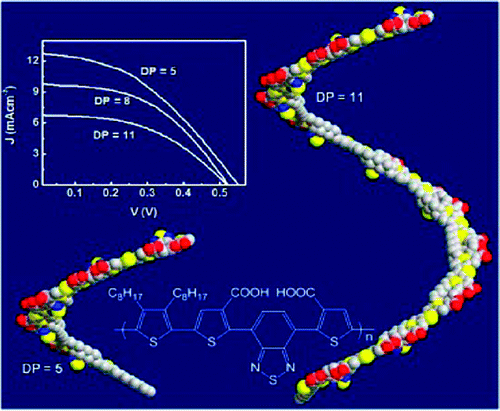当前位置:
X-MOL 学术
›
J. Am. Chem. Soc.
›
论文详情
Our official English website, www.x-mol.net, welcomes your
feedback! (Note: you will need to create a separate account there.)
Low-Bandgap Donor−Acceptor Conjugated Polymer Sensitizers for Dye-Sensitized Solar Cells
Journal of the American Chemical Society ( IF 14.4 ) Pub Date : 2011-03-09 , DOI: 10.1021/ja109926k Zhen Fang 1 , Aaron A. Eshbaugh 1 , Kirk S. Schanze 1
Journal of the American Chemical Society ( IF 14.4 ) Pub Date : 2011-03-09 , DOI: 10.1021/ja109926k Zhen Fang 1 , Aaron A. Eshbaugh 1 , Kirk S. Schanze 1
Affiliation

|
A set of two donor-acceptor type conjugated polymers with carboxylic acid side groups have been synthesized and utilized as active materials for dye-sensitized solar cells (DSSCs). The polymers feature a π-conjugated backbone consisting of an electron-poor 2,1,3-benzothiadiazole (BTD, acceptor) unit, alternating with either a thiophene-fluorene-thiophene triad (2a) or a terthiophene (3a) segment as the donor. The donor-acceptor polymers absorb broadly throughout the visible region, with terthiophene-BTD polymer 3a exhibiting an absorption onset at approximately 625 nm corresponding to a ∼1.9 eV bandgap. The polymers adsorb onto the surface of nanostructured TiO(2) due to interaction of the polar carboxylic acid units with the metal oxide surface. The resulting films absorb visible light strongly, and their spectra approximately mirror the polymers' solution absorption. Interestingly, a series of samples of 3a with different molecular weight (M(n)) adsorb to TiO(2) to an extent that varies inversely with M(n). DSSCs that utilize the donor-acceptor polymers as sensitizers were tested using an I(-)/I(3)(-) electrolyte. Importantly, for the set of polymer sensitizers 3a with varying M(n), the DSSC efficiency varies inversely with M(n), a result that reflects the difference in adsorption efficiency observed in the film absorption experiments. The best DSSC cell tested is based on a sample of 3a with M(n) ∼ 4000, and it exhibits a ∼65% peak IPCE with J(sc) ∼12.6 mA cm(-2) under AM1.5 illumination and an overall power conversion efficiency of ∼3%.
中文翻译:

用于染料敏化太阳能电池的低带隙供体-受体共轭聚合物敏化剂
已经合成了一组具有羧酸侧基的两种供体-受体型共轭聚合物,并将其用作染料敏化太阳能电池 (DSSC) 的活性材料。该聚合物具有 π 共轭骨架,由缺电子 2,1,3-苯并噻二唑(BTD,受体)单元组成,与噻吩-芴-噻吩三联体 (2a) 或三联噻吩 (3a) 链段交替捐赠者。供体-受体聚合物在整个可见光区域都有广泛的吸收,三联噻吩-BTD 聚合物 3a 在大约 625 nm 处表现出吸收起始点,对应于 ~1.9 eV 带隙。由于极性羧酸单元与金属氧化物表面的相互作用,聚合物吸附到纳米结构 TiO(2) 的表面上。所得薄膜强烈吸收可见光,它们的光谱近似反映了聚合物的溶液吸收。有趣的是,一系列具有不同分子量 (M(n)) 的 3a 样品吸附到 TiO(2) 的程度与 M(n) 成反比。使用供体-受体聚合物作为敏化剂的 DSSC 使用 I(-)/I(3)(-) 电解质进行了测试。重要的是,对于具有变化 M(n) 的一组聚合物敏化剂 3a,DSSC 效率与 M(n) 成反比变化,这一结果反映了在薄膜吸收实验中观察到的吸附效率差异。测试的最佳 DSSC 电池基于具有 M(n) ∼ 4000 的 3a 样品,并且在 AM1.5 照明下,它表现出 ∼65% 峰值 IPCE,J(sc) ∼12.6 mA cm(-2) 和整体功率转换效率约为 3%。一系列具有不同分子量 (M(n)) 的 3a 样品吸附到 TiO(2) 的程度与 M(n) 成反比。使用供体-受体聚合物作为敏化剂的 DSSC 使用 I(-)/I(3)(-) 电解质进行了测试。重要的是,对于具有变化 M(n) 的一组聚合物敏化剂 3a,DSSC 效率与 M(n) 成反比变化,这一结果反映了在薄膜吸收实验中观察到的吸附效率差异。测试的最佳 DSSC 电池基于具有 M(n) ∼ 4000 的 3a 样品,并且在 AM1.5 照明下,它表现出 ∼65% 峰值 IPCE,J(sc) ∼12.6 mA cm(-2) 和整体功率转换效率约为 3%。一系列具有不同分子量 (M(n)) 的 3a 样品吸附到 TiO(2) 的程度与 M(n) 成反比。使用供体-受体聚合物作为敏化剂的 DSSC 使用 I(-)/I(3)(-) 电解质进行了测试。重要的是,对于具有变化 M(n) 的一组聚合物敏化剂 3a,DSSC 效率与 M(n) 成反比变化,这一结果反映了在薄膜吸收实验中观察到的吸附效率差异。测试的最佳 DSSC 电池基于具有 M(n) ∼ 4000 的 3a 样品,并且在 AM1.5 照明下,它表现出 ∼65% 峰值 IPCE,J(sc) ∼12.6 mA cm(-2) 和整体功率转换效率约为 3%。重要的是,对于具有变化 M(n) 的一组聚合物敏化剂 3a,DSSC 效率与 M(n) 成反比变化,这一结果反映了在薄膜吸收实验中观察到的吸附效率差异。测试的最佳 DSSC 电池基于具有 M(n) ∼ 4000 的 3a 样品,并且在 AM1.5 照明下显示出 ∼65% 峰值 IPCE,J(sc) ∼12.6 mA cm(-2) 和整体功率转换效率约为 3%。重要的是,对于具有变化 M(n) 的一组聚合物敏化剂 3a,DSSC 效率与 M(n) 成反比变化,这一结果反映了在薄膜吸收实验中观察到的吸附效率差异。测试的最佳 DSSC 电池基于具有 M(n) ∼ 4000 的 3a 样品,并且在 AM1.5 照明下,它表现出 ∼65% 峰值 IPCE,J(sc) ∼12.6 mA cm(-2) 和整体功率转换效率约为 3%。
更新日期:2011-03-09
中文翻译:

用于染料敏化太阳能电池的低带隙供体-受体共轭聚合物敏化剂
已经合成了一组具有羧酸侧基的两种供体-受体型共轭聚合物,并将其用作染料敏化太阳能电池 (DSSC) 的活性材料。该聚合物具有 π 共轭骨架,由缺电子 2,1,3-苯并噻二唑(BTD,受体)单元组成,与噻吩-芴-噻吩三联体 (2a) 或三联噻吩 (3a) 链段交替捐赠者。供体-受体聚合物在整个可见光区域都有广泛的吸收,三联噻吩-BTD 聚合物 3a 在大约 625 nm 处表现出吸收起始点,对应于 ~1.9 eV 带隙。由于极性羧酸单元与金属氧化物表面的相互作用,聚合物吸附到纳米结构 TiO(2) 的表面上。所得薄膜强烈吸收可见光,它们的光谱近似反映了聚合物的溶液吸收。有趣的是,一系列具有不同分子量 (M(n)) 的 3a 样品吸附到 TiO(2) 的程度与 M(n) 成反比。使用供体-受体聚合物作为敏化剂的 DSSC 使用 I(-)/I(3)(-) 电解质进行了测试。重要的是,对于具有变化 M(n) 的一组聚合物敏化剂 3a,DSSC 效率与 M(n) 成反比变化,这一结果反映了在薄膜吸收实验中观察到的吸附效率差异。测试的最佳 DSSC 电池基于具有 M(n) ∼ 4000 的 3a 样品,并且在 AM1.5 照明下,它表现出 ∼65% 峰值 IPCE,J(sc) ∼12.6 mA cm(-2) 和整体功率转换效率约为 3%。一系列具有不同分子量 (M(n)) 的 3a 样品吸附到 TiO(2) 的程度与 M(n) 成反比。使用供体-受体聚合物作为敏化剂的 DSSC 使用 I(-)/I(3)(-) 电解质进行了测试。重要的是,对于具有变化 M(n) 的一组聚合物敏化剂 3a,DSSC 效率与 M(n) 成反比变化,这一结果反映了在薄膜吸收实验中观察到的吸附效率差异。测试的最佳 DSSC 电池基于具有 M(n) ∼ 4000 的 3a 样品,并且在 AM1.5 照明下,它表现出 ∼65% 峰值 IPCE,J(sc) ∼12.6 mA cm(-2) 和整体功率转换效率约为 3%。一系列具有不同分子量 (M(n)) 的 3a 样品吸附到 TiO(2) 的程度与 M(n) 成反比。使用供体-受体聚合物作为敏化剂的 DSSC 使用 I(-)/I(3)(-) 电解质进行了测试。重要的是,对于具有变化 M(n) 的一组聚合物敏化剂 3a,DSSC 效率与 M(n) 成反比变化,这一结果反映了在薄膜吸收实验中观察到的吸附效率差异。测试的最佳 DSSC 电池基于具有 M(n) ∼ 4000 的 3a 样品,并且在 AM1.5 照明下,它表现出 ∼65% 峰值 IPCE,J(sc) ∼12.6 mA cm(-2) 和整体功率转换效率约为 3%。重要的是,对于具有变化 M(n) 的一组聚合物敏化剂 3a,DSSC 效率与 M(n) 成反比变化,这一结果反映了在薄膜吸收实验中观察到的吸附效率差异。测试的最佳 DSSC 电池基于具有 M(n) ∼ 4000 的 3a 样品,并且在 AM1.5 照明下显示出 ∼65% 峰值 IPCE,J(sc) ∼12.6 mA cm(-2) 和整体功率转换效率约为 3%。重要的是,对于具有变化 M(n) 的一组聚合物敏化剂 3a,DSSC 效率与 M(n) 成反比变化,这一结果反映了在薄膜吸收实验中观察到的吸附效率差异。测试的最佳 DSSC 电池基于具有 M(n) ∼ 4000 的 3a 样品,并且在 AM1.5 照明下,它表现出 ∼65% 峰值 IPCE,J(sc) ∼12.6 mA cm(-2) 和整体功率转换效率约为 3%。


















































 京公网安备 11010802027423号
京公网安备 11010802027423号